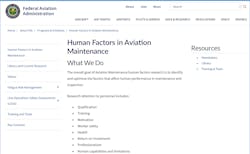Human Factors Interventions that Keep on Giving
For a long time, Regulatory Authorities (like the Federal Aviation Administration, Transport Canada, UK Civil Aviation Administration, European Union Aviation Safety Agency, Civil Aviation Safety Authority of Australia…), Manufacturers (like Boeing and Airbus), and Trade Organizations (like Airlines for America), and many academics have developed a variety of Human Factors (HF) interventions to support system safety and Safety Management Systems (SMSs) in airline maintenance/engineering organizations. Some safety interventions were a “flash in the pan” with limited US and international acceptance.
This article briefly describes seven widely accepted US-based HF interventions and offers the reasons they are widely-adopted with on-going use. The characteristics that contributed to wide-scale adoption should guide the development of new interventions.
The FAA Maintenance Human Factors Research Program
The FAA Office of Aviation Medicine embarked the Maintenance Human Factors Research Program (HF Program) in 1988 and continues to this day under the Human Factors Division of the Civil Aerospace Medical Institute (CAMI). Various HF interventions that evolved from the HF Program are described later in this article.
Why is the HF Program a Success?
- Industry and governments throughout the world needed a robust source for HF information and resources.
- The FAA Office of Aviation Medicine recognized the importance of providing maintenance HF information to not only FAA employees but also to the US domestic and international industry.
- FAA organized and sponsored maintenance HF conferences, which expanded from less than 50 delegates in 1988 and to nearly 1,000 delegates by 2001. The conferences were an educational forum and a critical means of information exchange early in the history of maintenance HF. By 2001 the term “Maintenance Human Factors” became a household name in aviation, meaning that “Maintenance HF” topics were integrated into broader aviation conferences.
The FAA Maintenance Human Factors Website
In the early years of The FAA HF Program, all of the annual conference presentations and Research & Development products were distributed on CD-ROMs. In 1994 FAA launched the Maintenance HF website (see https://www.faa.gov/about/initiatives/maintenance_hf or www.humanfactorsinfo.com). All conference proceedings, dating back to 1988, were moved to the website. FAA also archived NTSB maintenance-related event data dating back to the sixties. From nineties to today that website is the sole distribution site for products from the FAA Maintenance HF Program (e.g., HF Operator’s Manual). Most of the interventions described in this article are available via the FAA website. We estimate that the number of hits to the site exceeds 25 million since its inception.
What Made the FAA website a success?
- Early and continuing adopter of web-based technology
- High visibility for maintenance HF reports and products
- Free distribution
- Largest US/International source of Maintenance/Engineering HF information
Boeing MEDA
The Boeing Maintenance Event Decision Aid (MEDA) was created in the early nineties. While it hardly needs a description, it is a structured process to help organizations investigate maintenance events which has something to do with human performance. MEDA starts with the fundamental premise that “No maintenance worker starts the shift with an intention to error.” Therefore, when errors occur there must be a way to determine the factors that contributed to the undesirable event. MEDA offers the method to collect, organize, and analyze event data. Boeing provides necessary process, forms, training, and support.
What made MEDA a success?
- Broad participatory involvement was a Boeing design philosophy for MEDA. Collaborative Design, Development, and Test -The design team included: US and International representatives from airlines and MRO; regulatory representatives, labor representatives, maintenance HF specialists, and Boeing engineering and customer support specialists.
- The early beta-versions were extensively field tested. Process design was straight-forward and understandable.
- MEDA process met an industry need to investigate, understand and manage human behaviors such as errors and violations.
- Simplified Data Ownership: Early on developers decided that data should be kept locally and not to design an overly complex industry data sharing protocol.
- MEDA, as a systematic event investigation tool helped to shift the safety culture from blame to the just culture.
- Most importantly, Boeing delivered training and support to hundreds of aviation organizations (including customers and non customers) worldwide since 1995. That support continues today. Best source for MEDA information is [email protected]
The Maintenance Human Factors Presentation System (MHFPS)
The Maintenance Human Factors Presentation System (MHFPS) was posted to the FAA HF website in 2006. Knowing that maintenance HF training is best when it is customized to specific organizational characteristics, the MXHFPS offers hundreds of editable PowerPoint slides, 12 short videos, and over 50 animations (Flash Files that can be modernized), that cover most HF fundamentals. The slides support a live, or virtual, instructor to deliver the content. The MHFPS has been the basis for hundreds of maintenance HF offerings worldwide.
Why was MHFPS a Success?
- Content was generic and contained most of the content specified by EASA and other National Aviation Authorities,
- Content was easily editable,
- Content was highly visual, with relevant graphics, animations and movies
Maintenance Line Operations Safety Assessment (M-LOSA)
In 2008, the FAA sponsored a project to capitalize on the 10 plus years of success of normal operations audits on the flight deck and extend it to aviation maintenance and ramp operations by reshaping Line Operations Safety Assessment (LOSA) program to match the requirements of aviation maintenance and ramp environments. The Airlines for America Maintenance and Ramp HF Task Force (a core team of approximately 30 experts from the maintenance, ramp, and human factors communities) guided development of the maintenance and ramp LOSA forms, procedures, and software involved over three years. The M-LOSA implementation guidelines, forms, and training materials are available to the public (https://www.faa.gov/about/initiatives/maintenance_hf/losa).
Since late 2014, five airlines/maintenance organizations have M-LOSA programs running for at least two years. These organizations have observed significant safety performance improvement and positive safety culture shift due to M-LOSA. Singapore Airlines Engineering Companies Joint Ventures kicked off M-LOSA programs in several locations in Southeast Asia in 2020. About 10 additional organizations completed initial training and assessment of M-LOSA implementation. Boeing hosted the first MLOSA Best Practice Infoshare (Jun.12-14, 2019), which was attended by 27 representatives from five organizations (EASTEC/CEA, United Airlines, Air France, Singapore Airlines Engineering Company, KLM). This group of safety minded individuals offered a wide perspective from different levels in the workforce, common interest, to implement LOSA as a safety tool in the SMS.
Why is LOSA a Success
- MLOSA program had the industry input and buy-in from Day 1. The design and development of the maintenance and ramp LOSA forms, procedures, and training involved a taskforce of industry 30 experts from the maintenance, ramp, and human factors communities through numerous consultations combined with iterative development, testing, and refinement. Beta testing allowed input from over 100 maintenance technicians and ramp personnel for ramp, line maintenance, and base maintenance at numerous locations across the United States. Tests were conducted with Part 135 and Part 121 carriers. Both passenger and cargo operations were evaluated.
- MLOSA offers a predictive hazard identification process that is a critical part of an SMS in aircraft maintenance and ramp operations.
- M-LOSA allowed organizations to discover some systemic issues that went undetected by other safety efforts (e.g., self-reporting, investigation), their precursor latent conditions, as well as their mitigation.
- M-LOSA empowered frontline employees and brought forward many innovative solutions to safety concerns (e.g., toolboxes with fingerprint locks) and a large number of experiential learning videos produced by employees.
- FAA technical report “Implementation guideline for Maintenance Line Operations Safety Assessment Program” offers clear specific guidance for establishing the safety program.
- Boeing offers implementation support and training. All organizations that worked closely with Boeing have adopted a phased approach to allow them manage the scope of implementation and celebrate quick wins. All organizations paid particular attention to document success stories of their M-LOSA programs, and have been generous and eager to exchange best practices and lessons learned.
Fatigue Risk Awareness Training
Fatigue is a known significant risk in all human performance. The Fatigue Awareness Training Program (Fitness for Duty), in place for nearly 10 years, is a web-based training program. It is available from at www.humanfactorsinfo.com or www.faasafety.gov. With an estimated 1,000,000 users, the training is about 60 minutes in duration. There are versions for both maintenance and cabin crews. The training is supplemented with an award-winning fatigue awareness video, “Grounded” (See https://www.youtube.com/watch?v=FNsXpG4J8AQ)
Why is the Fatigue Awareness Training a Success
- Delivers relevant and applied fatigue awareness training
- Web-based delivery, available to users anywhere 24/7, no instructor needed; facilitator notes provided, can be easily adapted for in-person delivery
- No cost
- Supplemented with a realistic engaging 18-minute video
Procedural Compliance Support – The Buck Stops Here
Procedural Compliance (Following the Directions) is the primary hazard in aviation maintenance, and in all aspects of work and life. Mechanics/engineers know that following the technical documentation is a regulation. They usually have access to the necessary documents and they are capable of following the instructions. Most instructions are understandable and have been validated over extensive use. There are procedures to fix/clarify unclear procedures. Thus, procedural compliance is not a knowledge failure but, more likely a motivational commitment challenge. “The Buck stops Here” is a web-based training program that promotes 10 attitudes and behaviors of a Procedural Compliance Champion (see https://www.faasafety.gov/gslac/ALC/CourseLanding.aspx?cID=534). The training is supplemented with procedural compliance checklists for mechanics, managers, and procedure writers, respectively.
Why is the Buck Stops Here Successful?
- The training addresses a significant industry challenge – maintenance procedural compliance
- The web-based training is easily accessible by users around the world 24/7
- Free of charge, readily adaptable, saving aviation organizations a significant amount of investment in training design, development, and delivery
What have we learned from these Successful Examples
A common characteristic of highly-used safety interventions is ease of implementation into maintenance organizations of all sizes. The interventions are easily customizable. Each of the examples is matched to known industry needs. There is never an extensive requirement for ongoing support from government or external consultants. While Boeing and FAA have offered early assistance, it is not a requirement. There is no cost, except for internal management of an aviation organization, to take advantage any of the sources described above.
The Threat to These Successful HF Interventions and the Strategy for Moving Forward
SMS adoption and widespread acceptance is an important contribution to continuing safety. The examples above contribute to identifying, addressing, and promoting the corrective actions to reduce HF hazards. For the most part, government has radically reduced the applied research and development funding to continue and support creations like the interventions above. It is not likely that single aviation organizations will allocate the resources that the FAA Maintenance HF program has delivered for the past forty years. That situation is an emerging hazard.
To promote and expand effective HF interventions, we need connect and cross reference different resources globally. For example, EASA Human Factors Refresher Package (https://www.easa.europa.eu/community/topics/human-factors-refresher-package) and EASA Together4Safety Wellbeing Resource Hub (https://www.easa.europa.eu/community/content/wellbeing), a comprehensive career training portal to help individuals transition back into gainful employment.
““Dr. Bill” Johnson is a familiar name and face to many industry and government aviation audiences. Johnson has been an aviator for over 50 years. He is a pilot, mechanic, scientist/engineer, college professor, and senior executive during his career. That includes 16+ years as the FAA chief scientific and technical advisor for human factors.
Maggie Ma is a Certified Human Factors Professional (CHFP) who specializes in maintenance human factors, and a Boeing Technical Fellow. Maggie received her Ph.D. in Industrial Engineering/Human Factors Engineering in 2005 from State University of New York at Buffalo. She has 20 years of experience in conducting applied human factors research to improve aviation safety through developing various safety programs (e.g., event investigation, training, self-reporting, and observation of normal operations).
About the Author

Dr. Bill Johnson
Chief Scientific and Technical Advisor Human Factors in Aviation Maintenance, FAA
““Dr. Bill” Johnson is a familiar name and face to many industry and government aviation audiences. Johnson has been an aviator for over 50 years. He is a pilot, mechanic, scientist/engineer, college professor, and senior executive during his career. That includes 16+ years as the FAA Chief Scientific and Technical Advisor for Human Factors.
Dr. Bill has delivered more than 400 Human Factors speeches and classes in over 50 countries. He has 500 + publications, videos, and other media that serve as the basis for human factors training throughout the world.
Recent significant awards include: The FAA “Charles E. Taylor Master Mechanic” (2020); The Flight Safety Foundation - Airbus “Human Factors in Aviation Safety Award” (2018), and the International Federation of Airworthiness “Sir Francis Whittle Award” (2017).
Starting in 2021 Johnson formed Drbillj.com LLC. In this new venture he continues to bring decades of human factors experience to aviators, worldwide.

Maggie J. Ma
Associate Technical Fellow, Boeing
Maggie Ma is a Certified Human Factors Professional (CHFP) who specializes in maintenance human factors, and a Boeing Technical Fellow. Maggie received her Ph.D. in Industrial Engineering/Human Factors Engineering in 2005 from State University of New York at Buffalo. Maggie has 20 years of experience in conducting applied human factors research to improve aviation safety through developing various safety programs (e.g., event investigation, training, self-reporting, and observation of normal operations). She has authored over 70 technical publications, has chaired technical sessions, and is frequently a speaker at aviation safety conferences and workshops. She has worked closely with airlines, manufacturers, maintenance organizations, ground service providers, and regulatory agencies around the world.
Maggie joined the Boeing Company in January 2012. Her primary responsibilities include providing implementation support to customer airlines, maintenance organizations, and internal customers on a wide array of safety processes/programs, e.g., the Maintenance Event Decision Aid (MEDA) process, the Ramp Event Decision Aid process, Maintenance Human Factors training, a Safety Management System, Maintenance Line Operations Safety Assessment (LOSA), and Ramp LOSA. She also leads several Boeing initiatives and innovation projects. Maggie and her former lead, Dr. Bill Rankin received the Engineering Team of the Year Award for Boeing Commercial Aviation Services in February 2013. Maggie received the Boeing Service Culture Excellence Award in June 2018.
Previously, Maggie was a faculty member of Aviation Science at Saint Louis University and also worked as a senior usability consultant at Perficient Inc. She was an Amelia Earhart Fellow 2004-05.
Education
- Bachelor of Science (1999), Engineering Management, Beijing University of Technology.
- Master of Science (2002), Industrial Engineering/ Human Factors Engineering, SUNY-Buffalo.
- Ph.D. (2005), Industrial Engineering/ Human Factors Engineering, SUNY-Buffalo.
- Certificate (2019), Psychology of Leadership, Cornell University.
Professional Affiliation
- Human Factors and Ergonomics Society (HFES)
- Board of Certification in Professional Ergonomics: certified Human Factors Professional (CHFP)
- Boeing Community of Excellence in Human Engineering
- International Civil Aviation Organization (ICAO) Human Performance Task Force
- European Union Aviation Safety Agency (EASA) Human Factors Collaborative Analysis Group (HF CAG)
- FAA’s Research, Engineering, and Development Human Factors Subcommittee
- Airlines for America (A4A) Maintenance Safety Committee
- UK Royal Aeronautical Society Human Factors Group: Engineering (RAeS HFG:E) (corresponding member)
